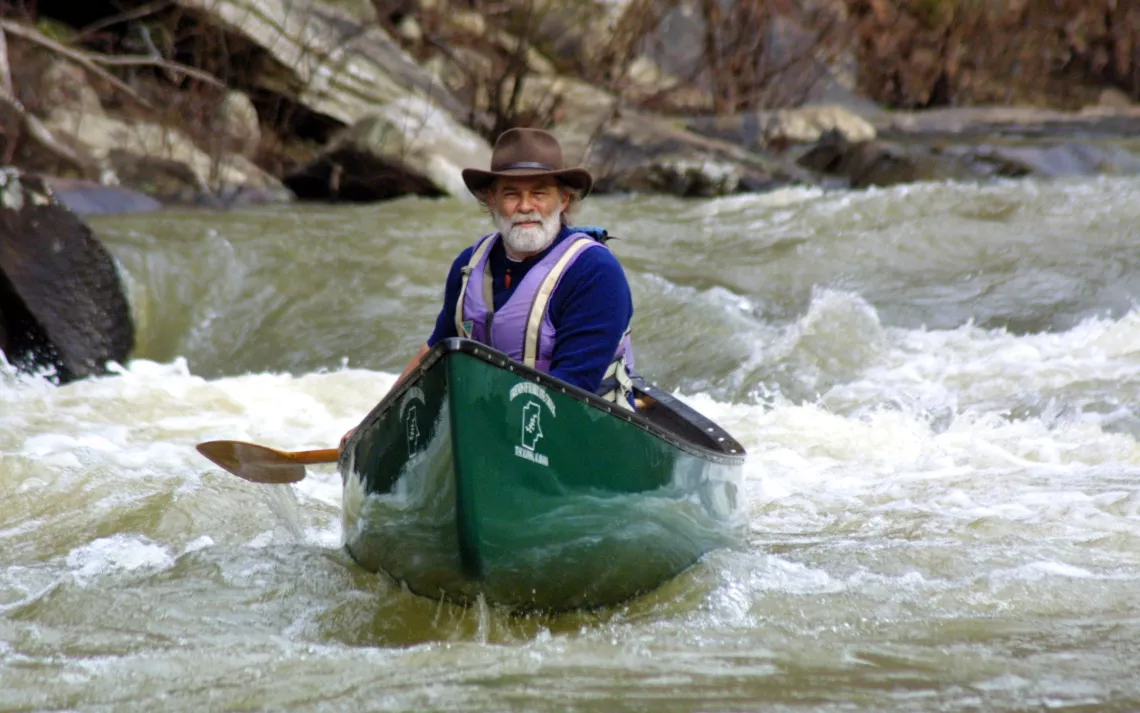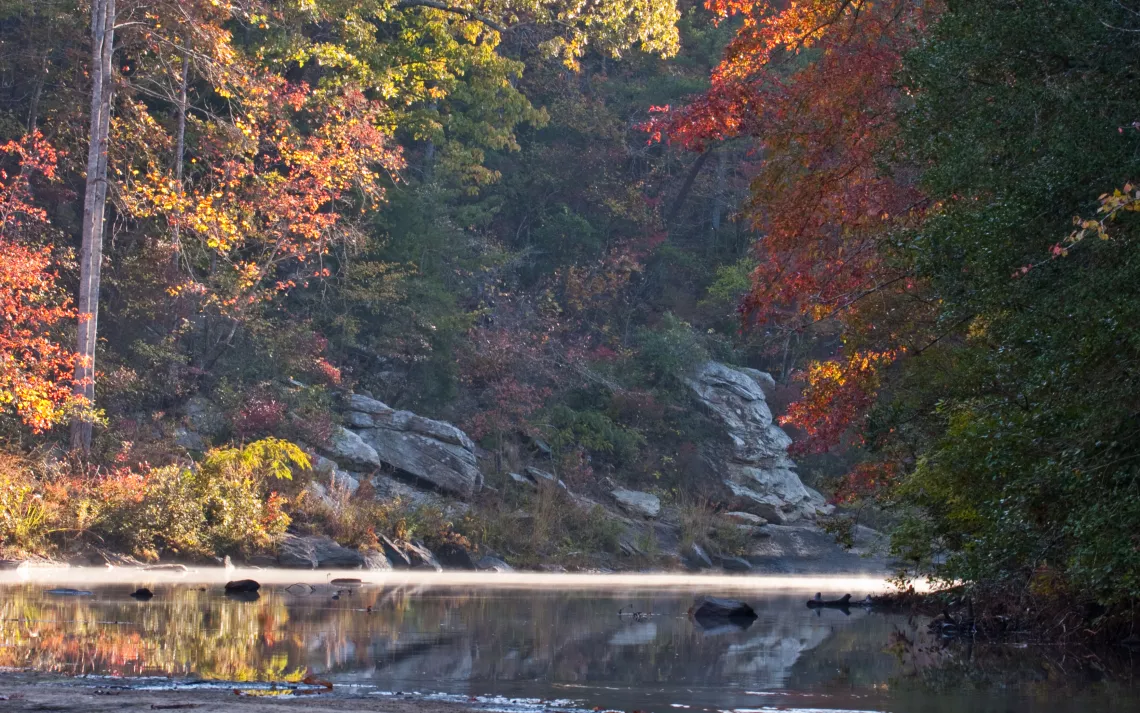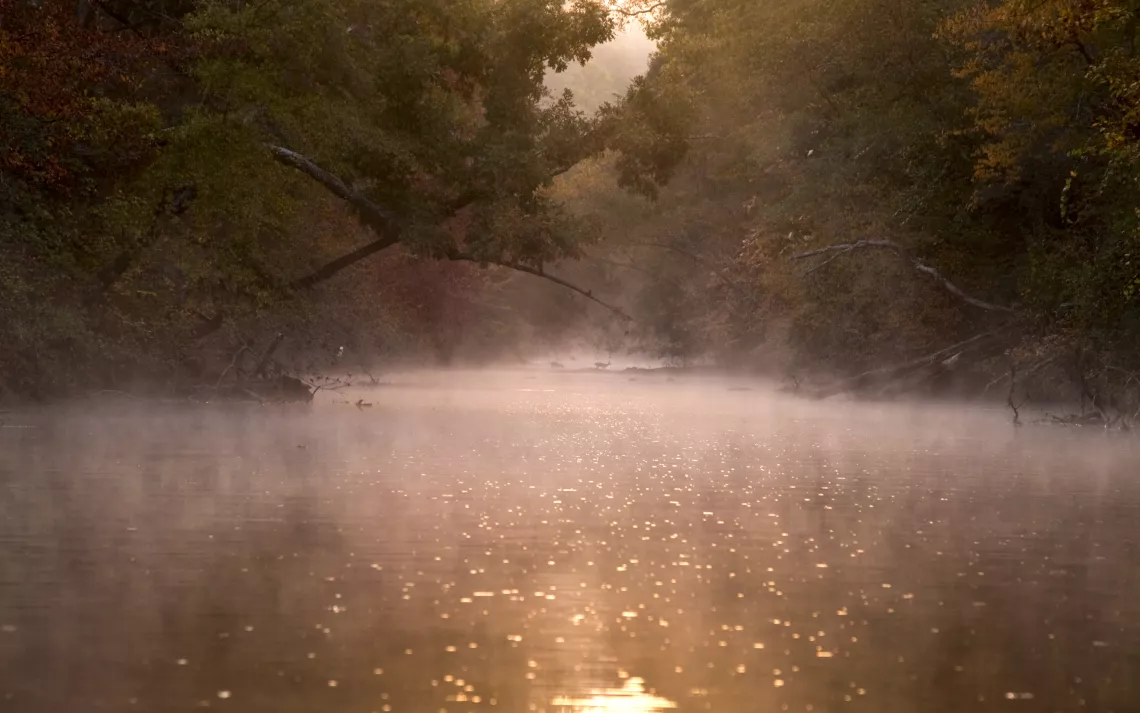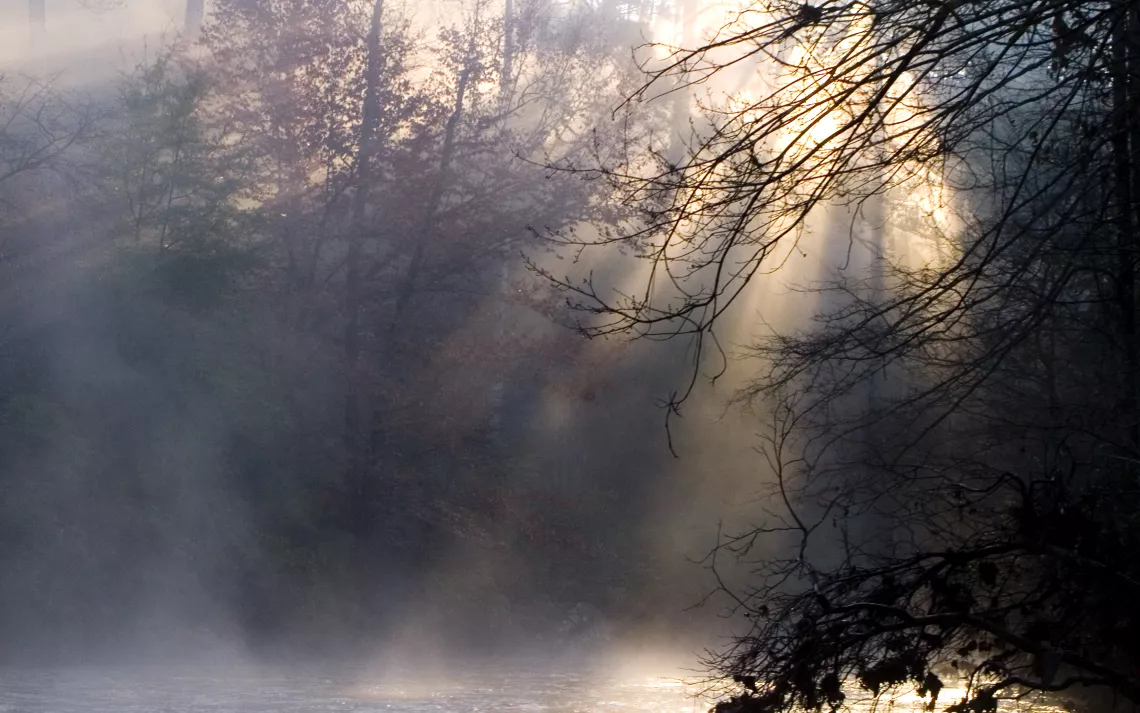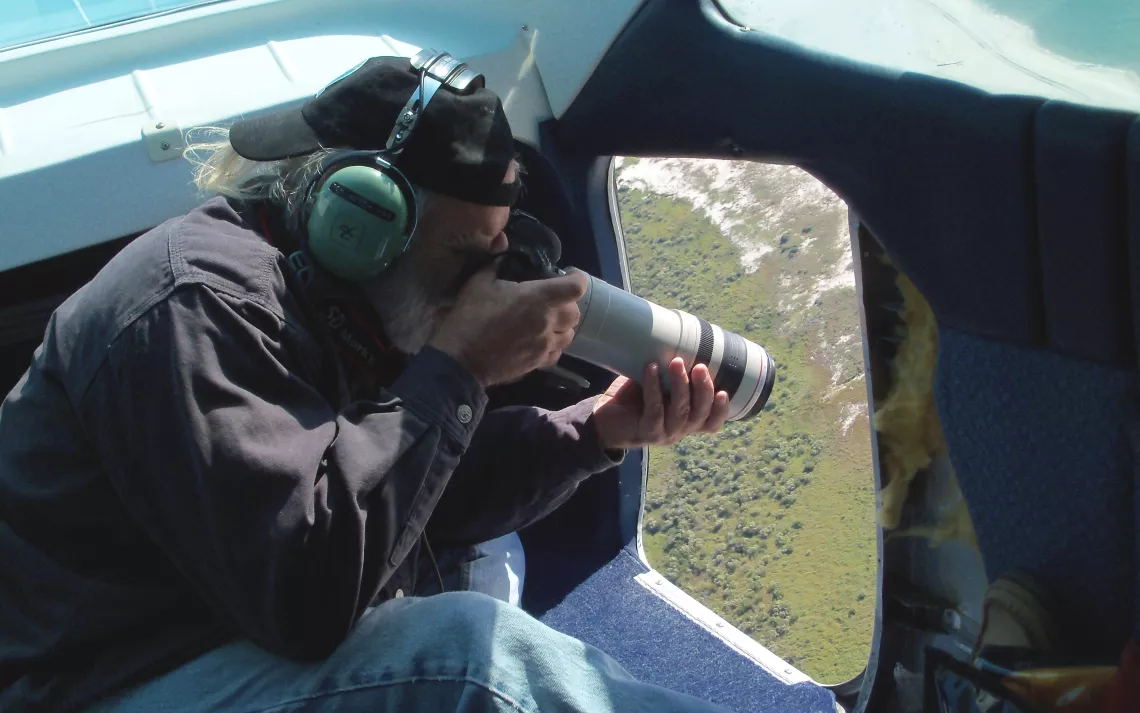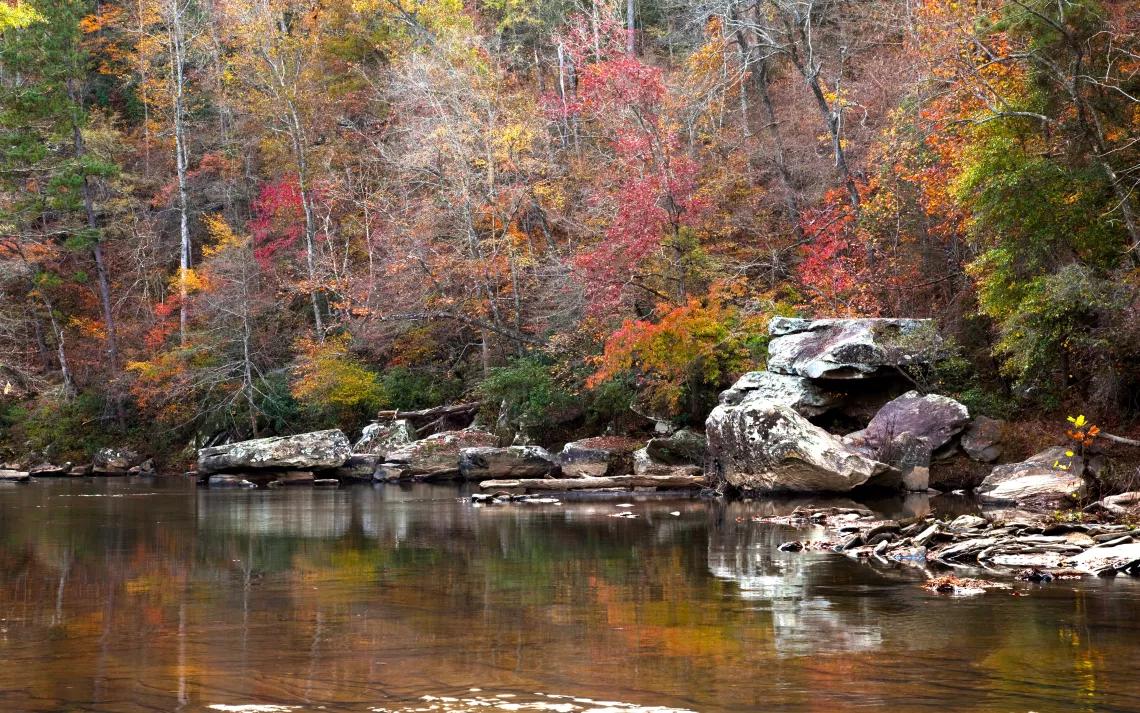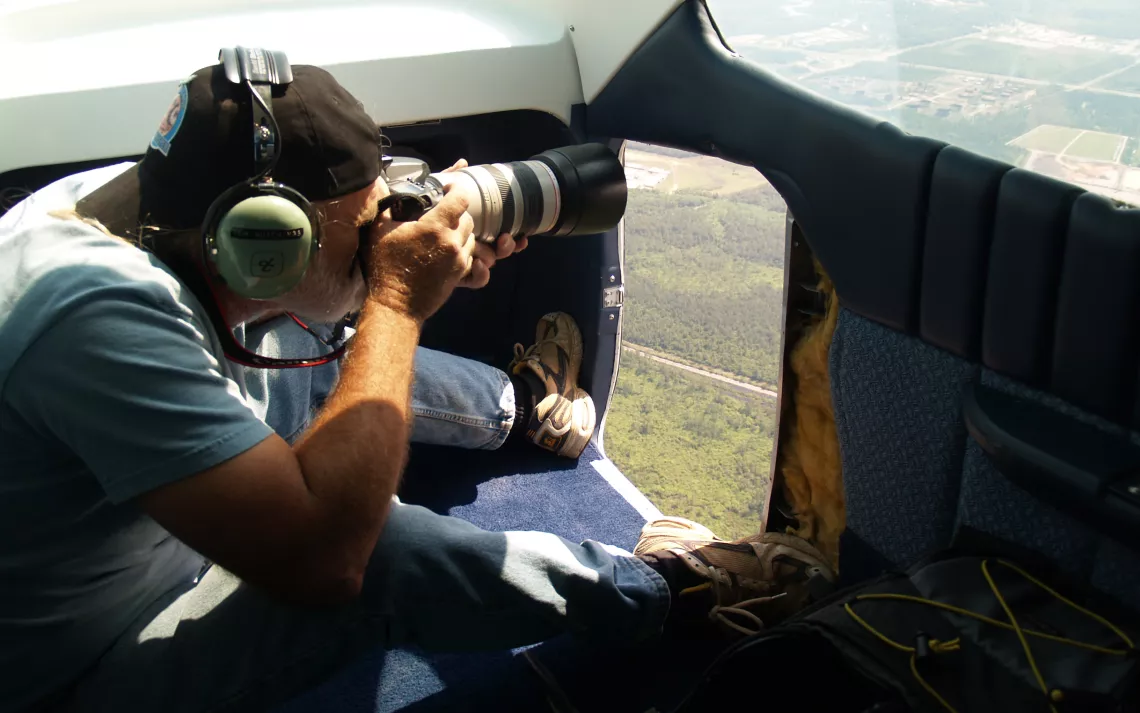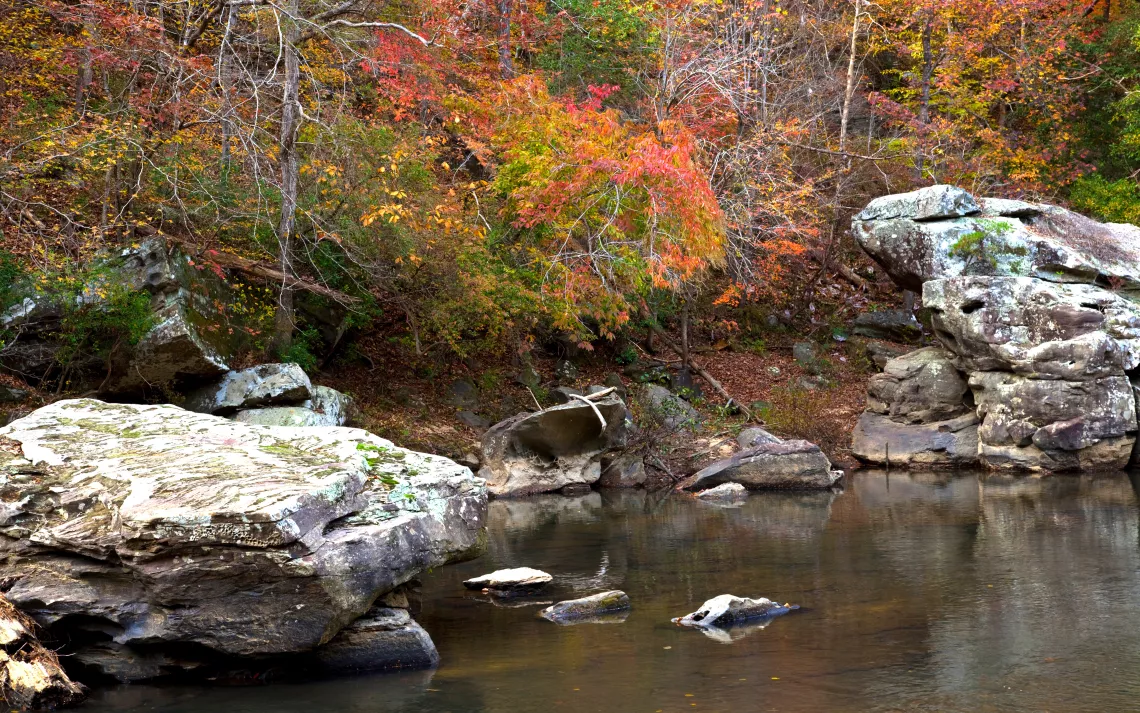By: Nancy Callahan
On April 26, 1999, the Sierra Club West Alabama Group forged a critical relationship with the Friends of Hurricane Creek, that stream being the love child of John Wathen and a band of other creek believers. It was a joint effort between the two groups called the Hurricane Creek Task Force, started by Peggie Griffin, then of Northport and a Sierra Club West Alabama activist.
More than 30 miles long, flowing only in Tuscaloosa County, “HAIR-uh-kin Creek,” its old timers’ moniker, is one serpentine shape after another, flanked by astronomical stones, some of which are in the creek; thick, towering hardwoods, wildflowers, including the rare silky camellia; and wilderness options from canoeing, fishing, and hiking, to listening to manifold cadences of birds. As the stream runs from Vance to the Black Warrior River, water hits hard at the rocks and the outcome is a hurricane sound, through this last free-flowing stream in Western Appalachia.
On a fault, part of the creek came together two million years ago. The other segment dates back more than 320 million years. Buoyed by veins of coal, it was in the genesis of the Warrior Coal Basin – the counties of Tuscaloosa, Walker, and Jefferson, where coal mining unfolded as an economic boon in 19th Century Alabama.
Peggy asked John and a few others in his cluster, including myself, to work together to convince the Alabama Department of Transportation (ALDOT) to change the specific locale of a planned eastern bypass. The bypass was put forth by ALDOT and the City of Tuscaloosa to enable what those entities envisioned as a better flow of traffic in the eastern part of the city.
The two conservation groups had learned that a bridge was going to be erected through the creek’s M Bend, a double arc seen from the air as the letter M, over and adjacent to Hurricane, off Alabama Highway 216. Much of the M Bend - 249 acres, later was purchased by the Tuscaloosa County Park and Recreation Authority (PARA) and is now known as Hurricane Creek Park, what John calls “some of the most pristine land left in Hurricane Creek in one chunk.”
The bridge likely would destroy majestic bluffs millions of years old, long adored by recreators, including “honeycomb” rocks taking eons to form from water coursing drip by drip. Animal life could be threatened by construction sounds, physical intrusion of the bridge, and gasoline fumes. Litter thrown out from bridge travelers could fly in the face of the creek’s reverence and beauty.
Plus, stories kept emerging about Native American artifacts having been found in the water body there and on a high-up path adjacent to the creek, where caves are present. Sam Curran, of McCalla, a Creek elder and Indian scholar, said that the walkway had been a part of the Bear Meat Path, an ancient trail originating from around Nashville, crossing into Alabama and the Cahaba River Watershed, and coming up from the creek mouth at its spill into the river at Fox, a lumber industry ranging through the first few decades of the 1900s, and now a ghost hamlet near Holt.
The Hurricane Creek Task Force went to work, meeting as often as every two weeks, or weekly, if needed, ironing out ways to persuade ALDOT, through public outcry, to change the bridge route to a stretch 1500-1800 feet northeast, which would not destroy this grand creek component. John had been up to his eyeballs monitoring coalmine pollution of Hurricane and figuring how to stop that creek scourge, ongoing since the 1920s. He also was a member of the Citizens Coal Council, a Washington, D.C. team advocating for citizen rights in the coal arena.
He found out that Alabama endured more mine-land reclamation problems than any other state. Too, he discovered vast inequities in the amount of reclamation monies received by Alabama versus the state’s number of abandoned coalmines needing reclamation. At that time, he stated, 741 such dangers existed in Alabama.
Peggie’s leadership was supreme. John had contacts. The task force was on a mission. John bent the ears of ALDOT officials at local and state levels. He enjoyed relationships with TV and radio figures. He was acquainted with his congressman. The Tuscaloosa News was clearly on our side. Story after story quoted John about his passion to save the honeycombs, to honor evidence of Indian travel here, to allow future generations to reap the M Bend blessings of what he and Peggie called the “crown jewel” of Tuscaloosa County.
With his keen quick blue eyes, nearly snow-white hair and beard, a flashy red bandana, and a faithful dog, John likely knows Hurricane as intimately as anyone ever has. Even prior to his task force work, he had been up and down, inspecting and reporting, always on the prowl, by canoe, foot and – later, by helicopter, to stomp out pollution and polluters. “The most dangerous tool we’ve got right now,” he declared ten years ago at a Friends gathering, “is the airplane.” When developers or coal industry folks install gates and say, “No, you can’t come in,” John swings to Plan B: “I just call one of my pilots and we do a flyover, taking high aerial photographs. I’m able to get close, blow up the photos, and read their tag numbers.” People paired the stream with John, or “that man on TV.” They called him to vent or get help with creek issues.
By 2002, the by-pass had not yet leapt up from the drawing board. The Tuscaloosa News, August 1 of that year, ran an article headlined “National Sierra Club slams Eastern Bypass.” Said the report, “A map released this week by the national Sierra Club points to the planned Eastern Bypass as one of the worst examples of transportation projects in the country.” As the piece continued, “Of the 26 “wrong-way” projects listed across the country, the Eastern Bypass is the only one in Alabama. It received low marks from the group because of the impact the highway will have on the cliffs of Hurricane Creek.”
Years later, local ALDOT leaders admitted that the Friends had stalled the by-pass. Then, more years went down, with occasional reports or rumors about its near reality, spawning emotional abuse to and confusion within the weary honeycomb niche. Earlier this summer, I asked an ALDOT right-of-way staffer what about it. “The eastern by-pass has been pushed way back. At this time, it’s not even a priority.”
Peggie had set in motion the campaign. In January 2003, she moved on to life farther north in Gallant and as a National Sierra Club staffer, with work she already had begun in Northport. John remained as the Friends executive. In 2005, we were invited into Waterkeeper Alliance, an international grassroot effort to save the world’s water, started by Robert F. Kennedy, Jr., who got wind of John’s work, came to Holt, and the twosome walked the creek at Watson’s Bend, downstream of the M Bend. Wathen’s title was changed to Hurricane Creekkeeper, with Waterkeeper Alliance.
It has been an amazing ride, here and beyond. Mentored by Beth Maynor Young, a Birmingham area nature photographer of Southern renown, he took air and ground photos of the 2010 oil spill in the Gulf of Mexico, issuing written and visual reports that, according to his then-wife Renee, received two million hits on his blog, BP Slick. Often, his accuracy was the only truth being told.
In 2011, an EF-4 tornado struck Tuscaloosa County, including Watson’s Bend, named for the owning couple, Addalyne and Jimmy Watson, both now deceased. The Watsons had enabled creek clean-ups there as annual traditions off Holt-Peterson Road. “In one clean-up, we had to take out an old junk car, right there in the water,” he shook his head as in disbelief. Post-tornado, John, who had videoed the dragon while it “sucked up” the creek, led volunteers from cross-country in creek site clean-up, saving the county thousands of dollars. He was absent from the 2012 clean-up because of work in New Zealand, sponsored by Green Peace, mentoring, teaching, and inspiring.
In November 2013, he was in small-town Aliceville, west of Tuscaloosa, doing more photojournalism at an oil spill noted nationwide. A train pulling 2.7 million gallons of crude oil exploded and spewed into adjacent wetlands. The honesty of John’s images caused questions to shoot up and out about the railway’s clean-up protocol which seemed to be placing the wetlands at high risk of destruction.
In 2016, with his skills in photography, videography, and reportage ever evolving, and with his mouth, John spent several months in Standing Rock, North Dakota, amongst Sioux Indians fighting to keep the Dakota Access Pipeline from obliterating their sacred sites – their heritage, including burial grounds. Mostly pro bono, and with a nod from Waterkeeper Alliance, he documented the heinous chapter, his work seen globally. From John’s heart, he was representing the Friends back home. “The Sioux are our brothers and sisters.”
He long had been a proponent of physically preserving and paying spiritual homage to Hurricane’s bygone Indian cultures. One instance was his tireless but depressing stand to preserve what he believed was an Indian burial ground and cave perhaps of erstwhile sacred ceremony on coalmining property off an upper creek realm at Brookwood. The coal company ultimately destroyed the site. He also likes to show off a “prayer rock” he thinks was used by Indians in a part of Hurricane fringing his backyard near the Watson acreage.
John has a body tattoo that seems symbolic enough for Sigmund Freud to cast lots for the pleasure of seeking its myriad meanings, had Dr. Freud been around in these times. It is an Alligator Snapper turtle of hungry demeanor, enough to scare any Halloweener, with mouth open wide to lure a Caddisfly larvae (Trichoptera), also a player on the tattoo. John knows that the Alligator Snapper is the largest freshwater snapping turtle in North America. The being can weigh as much as 200 pounds and live as long as 100 years. The tiny Caddisfly larvae, sensitive to water pollution and an enchantment to children, signifies the creek food chain’s lowest level. He wants Hurricane to be healthy for every rung of the chain of life, from top to bottom, and especially for children.
“We’ve made a lot of headway on Hurricane Creek over the years,” he reflected. “It’s healthier now than when I got here. I promised my grandchildren it will be better before I leave. You‘ve got to do what you promised your grandbabies. Right?”
The challenges continue in 2017. The Creekkeeper has labored for years to report code-ignorant and devil-may-care developers whose construction site run-off gets into the creek or a feeder. But he thinks the issue is not as much of a problem as in his early watch. His face turns red at the thought of fracking. He is mortified that the first fracking in the nation was birthed in northeastern Tuscaloosa County – coal country, the same swath where Hurricane Creek prances and dances over the rocks. John says that the Alabama Department of Environmental Management (ADEM), or what he calls the department of environmental “monsters,” looks the other way when water pollution is so obvious, an entrenched pattern. They issue permits not worth the paper on which they are written.
In his poignancy, “Everyone should have a right to come down to Hurricane Creek, catch a fish, take it home and eat it, and not be afraid of the pollutants that may be contaminating you or your family. Those rights have been stolen from us over the years by lack of compliance to federal regulations, irresponsible permitting on behalf of ADEM, and other interests really pushing Alabama to open its doors to polluters unchecked. This is our waterway and somebody has to protect it. Our government is not doing it for us so we the citizenry have to take responsibility.”
He lives for the day when the governor and the legislature will finally do what is right - create an honest-to-God, viable state environmental management authority, one not above the law, no monsters at work or slothen, peacockish behaviors allowed. Only this month, Tuscaloosa sewage issues were a top news media story, but in a positive frame. Sewage spills into creek feeder streams and then into Hurricane itself have been the focus too long of John’s energies. “It was testy for a while.” But he has made friends with city officials and is an unofficial adviser throughout the county on ways to address with environmental soundness sewage spills into streams.
On Sunday, July 23, 2017, the lead piece on page one of The Tuscaloosa News, “Critic praises sewer spill alert system,” featured John’s take on new methods, including better communication with those living in impacted areas. “For almost two decades, Tuscaloosa area environmental advocate John Wathen has decried the city’s efforts to curb and notify the public of sewer spills.
“But today, the Hurricane Creek Creekkeeper is praising the city for a change in direction.
“All the pressure has made a difference,” he said. Citing specifics of improvement, the article concluded with John again: “I think they’re actually listening to us.”
It is worth any nature person’s time to sit in on a power point staged by the Hurricane leader: high art, right-brain doings. He shows snow scenes, rarely seen by those who do not partake of the creek in low temps. “It is absolutely gorgeous,” he once raved. “If it’s snowing, I’m going paddling, regardless of how cold it is.” He changes the visual to one of spawning redhorses. “We have fish!” he hoorayed. “When I started walking the creek, I never saw fish. If the redhorses are spawning, Hurricane Creek is healthy enough for ‘em to come back.” Along with fish, he effused, are snakes, including a banded water snake, a two-pound bass underneath the snake. “In times past, we didn’t have snakes because we didn’t have fish. This bass is a nice-sized fish. I’d eat him.”
He switches to a creek mouth picture. “Bright and early, I like to get out there while the fog’s still on the water, looking like dinosaurs coming down.” Next is a mountain laurel. “It’s a bright pink blanket.” And a big leaf magnolia, a relic plant from Canada. “It was left here after the glaciers. They’ve gotta have some shade to keep the bright hot Southern sun from cooking ‘em. But they will survive where God put ‘em.”
John runs an impromptu “ambulance service” for raptors, shown in a presentation with his photo of a hawk he found. “When people call and say they’ve got an injured bird in their yard, or one stuck in a fence, I’ll get the bird, put it in a box, and take it up to the Alabama Wildlife Rehab Center. They’ll get it healthy again and bring it back to Hurricane Creek where we release it. This bird was released from my front yard. I call him “Free Bird.” Now comes an owl, followed by an American bittern. “I’m told it’s hard to get a photograph of the bittern because it’s such a reclusive bird. This one landed in our yard and strutted around for an hour while Renee and I were watching. It was great!”
As an annual rite, John and his boat buddies take a New Year’s Day paddle trip from the creek’s upper regions to its bottoming out. The trek takes hours, daylight till dark, sheer natural glory, Godly rises and sets of the sun, icicles hanging from sandstones, birds still here despite winter diaspora, and jewel-like stars lighting a dark, cold, January night. Brrrh. “If any of you want to go with me, come on, and if you see me out in the water, wave. I’ll stop and talk to anybody. If we can ever get enough water that you’re not walking through the creek, we’ll take y’all floating some time.”
But keep in mind, like the Creekkeeper once warned in a slide show, “A snapping turtle is very docile until he’s messed with. You mess with my creek? I’ll bite you.”
Copyright 2017 by Nancy Callahan
The author is a member of the Friends of Hurricane Creek board of directors. Her book about the creek and its diverse nature and culture is available through Crescent Ridge Publishing.
